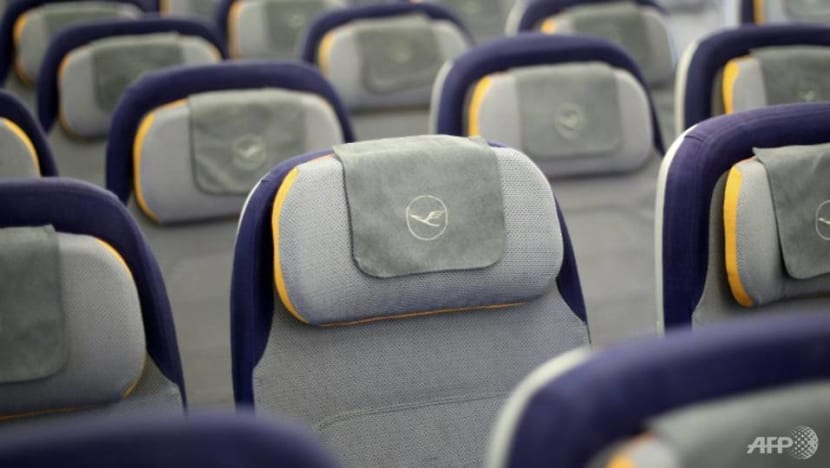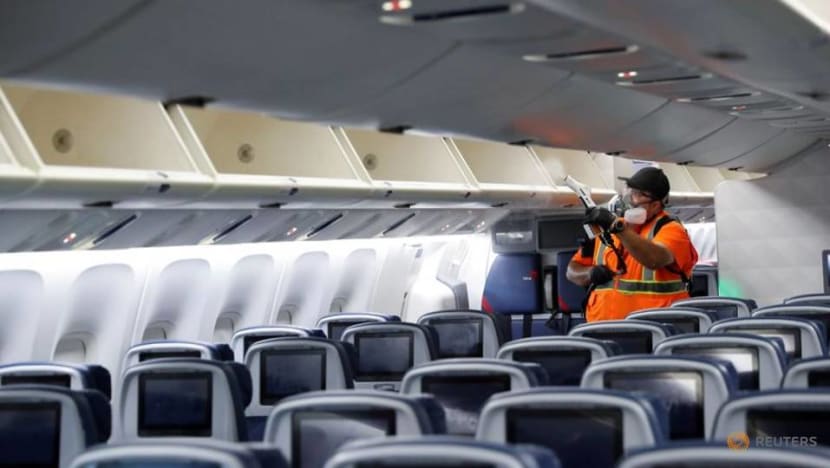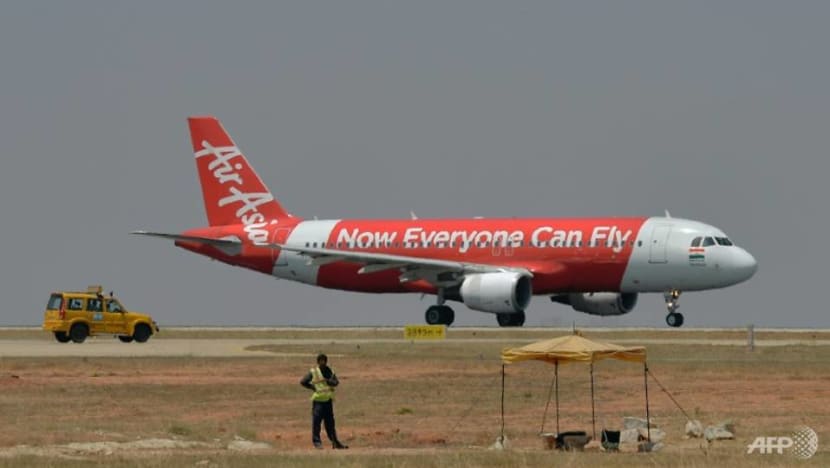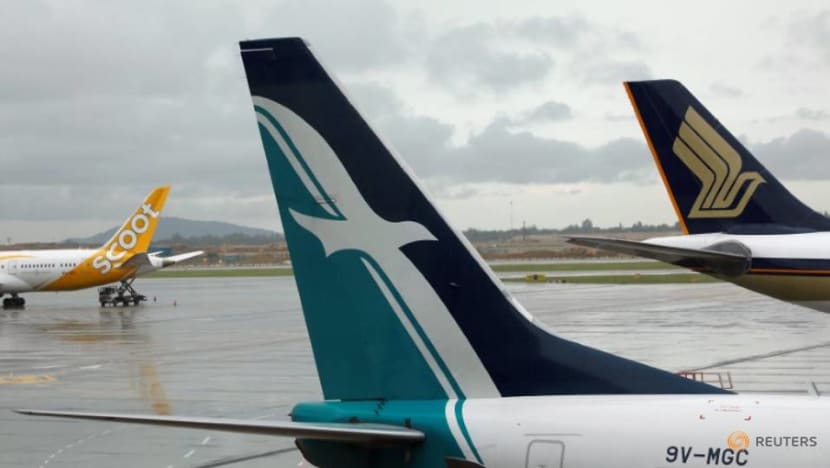commentary Commentary
Commentary: Asian airlines may never recover without consolidation
The region was ripe for airline consolidation even before COVID-19 but this crisis is not about to open the floodgates, says Brendan Sobie

The disappearance of business travellers is a big problem for airlines. (File photo: AFP/Daniel ROLAND)
SINGAPORE: Long overdue consolidation is finally coming to Asia’s battered airline sector with COVID-19 precipitating the merger of South Korea’s two main airlines.
On Monday (Nov 16), Korean Air (KAL) and holding company Hanjin KAL announced the acquisition of Asiana Airlines as part of an agreement with Korea Development Bank (KDB).
The merger will enable KAL to become one of Asia’s five largest airline groups.
The KAL and Asiana groups combined carried 66 million passengers in 2020 and generated over US$10 billion in passenger revenues. When including cargo and other businesses revenues totalled over US$16 billion.
READ: Commentary: I never planned to visit Hong Kong anytime soon, but the air travel bubble might change that
READ: Commentary: Hong Kong and Singapore air travel bubble could be a game-changer
In Asia Pacific, only Japan’s ANA Holdings, Air China, China Eastern and China Southern generated more revenues in 2019 – between US$17 billion and US$22 billion.
In comparison, Singapore Airlines (SIA) Group generated almost US$10 billion in revenues in 2019 and carried 38 million passengers while Cathay Pacific Group generated almost US$14 billion and carried 39 million passengers.
ADDRESSING OVERCAPACITY IN KOREA
The Asiana-Korean Air merger is sensible as the airline industry in South Korea – as well as in Asia overall – was ripe for consolidation.
Even before COVID-19, the South Korean airline industry suffered from overcapacity and irrational competition.

South Korea does not really have a need for two full service network airlines given the size of its market - 123 million annual passengers in 2019 - the rapid rise of low-cost carriers over the last decade and the intensifying competition from foreign airlines.
Asiana and KAL have significant overlap, both operating large long-haul networks from hubs at Seoul Incheon Airport with aircraft as large as A380s as well as big regional networks within the Asia-Pacific.
READ: Forming an air travel bubble with Singapore: After Hong Kong, which destination could be next?
READ: Commentary: The Boeing 737 MAX is almost ready to fly again
Overcapacity has become a common issue throughout Asia in recent years, impacting airline profitability as network airlines competed viciously for intercontinental traffic and faced intensifying competition on regional routes from budget airlines.
South Korea now takes the lead in driving a potential new wave of consolidation in Asia’s airline sector.
AIRLINE GROUPS CONSOLIDATING
As KAL stated in announcing the acquisition of Asiana: “Given the crisis the airline industry is currently facing, it is unavoidable to restructure the entire market, including Korean Air, Asiana Airlines, the low cost carriers (LCCs) such as Jin Air and relevant industries.”
KAL has a majority stake in Jin Air while Asiana has two LCCs, fully owned Air Seoul and partially owned Air Busan. All three will be part of the merger and are expected to become a single LCC.

Asiana will be kept as a separate full-service airline for the time being but the merger plan includes the Asiana brand eventually disappearing.
The KAL Group will therefore consolidate under one major full-service network airline and one large LCC subsidiary.
Several other Asia Pacific airline groups have similarly consolidated brands in recent years, including SIA – which dropped Tigerair n 2017 and is dropping SilkAir in 2021, leaving only Singapore Airlines and Scoot.
READ: Commentary: More than S$600 for first class meals? SIA isn't for everyone but that's just fine
Other recent examples of airline brand consolidation in Asia include ANA merging LCCs Peach and Vanilla in 2019, resulting in the Vanilla brand disappearing, and Cathay Pacific dropping Cathay Dragon last month.
THE COVID-19 EFFECT
However, consolidation involving two airline rivals has been extremely rare in Asia over the last couple of decades while relatively common in Europe, North America and Latin America.
For example, five major US mergers were completed between 2008 and 2016: Delta Air Lines-Northwest Airlines, AirTran Airways-Southwest Airlines, Continental Airlines-United Airlines, America Airlines-US Airways and Alaska Airlines-Virgin America.

While commercially sensible even before COVID-19, KAL taking over Asiana would never have been politically feasible if it were not for the pandemic.
The current crisis, which pushed an already weaker Asiana to the brink of collapse, created an attractive opportunity for KAL that would be foolish not to pursue.
Now the question becomes if other markets in Asia will follow similar consolidation moves.
ASIAN MARKETS ARE RIPE FOR CONSOLIDATION
There is no shortage of markets ripe for airline consolidation in Asia.
Taiwan also has two full service network airlines – as well as an ambitious full-service start-up that launched at the beginning of this year – despite being a much smaller market than Korea, consisting 69 million annual passengers in 2019.
READ: Commentary: We must save Singapore Airlines from this existential crisis
Malaysia, a market of 82 million annual passengers in 2019, has two full service airlines and is the main base for Asia’s largest LCC – AirAsia.
Philippines, Thailand and Vietnam are other medium-sized markets that would benefit from consolidation.

Smaller markets such as Cambodia and Myanmar have several local airlines, also making them obvious candidates for consolidation, but on a different scale given they do not have any large carriers.
However, mergers or acquisitions similar to the Asiana-KAL deal cannot be assumed.
CROSS-BORDER CONSOLIDATION NEEDED
In other Asian markets, including Malaysia where mergers were mooted in 2019, the focus during the pandemic has been on each airline getting its own house in order rather than mergers or acquisitions.
Consolidation could be achieved through airline collapses rather than mergers or acquisitions but this may be limited to a few smaller competitors as governments and industry partners have too much at stake to let larger airlines fail.
What Asia really needs is cross-border mergers and acquisitions – which is how the European market has successfully consolidated over the last several years with another wave perhaps forthcoming.
READ: Commentary: Flights to nowhere raise bigger questions about Singapore Airlines’ future
Germany’s Lufthansa Group now includes airlines in four countries – Austria, Belgium, Germany and Switzerland - while British Airways parent IAG includes airlines in three countries –Ireland, Spain and the UK.
SIA AND CATHAY COULD BENEFIT
Cross-border mergers would give Asian airlines – particularly those outside the main markets of China, India, Indonesia and Japan – efficiencies to better compete in the post-COVID environment.
They would be the only vehicle enabling Cathay Pacific and SIA to match the new KAL in size.
Cathay, SIA and other major Asian airlines should benefit from the Asiana-KAL merger as it opens up opportunities for expansion in South Korea.

SIA could potentially resume Korea-US services, which it ceased in late 2018, particularly as it will lose Asiana as a partner.
However, SIA will not be able to overtake KAL and move into Asia’s top five without a cross-border merger or acquisition.
ARCHAIC OWNERSHIP RESTRICTIONS
At least for now, airline ownership restrictions make cross-borders mergers impossible to pursue anywhere in the Asia-Pacific.
While COVID-19 could be viewed as a potential trigger to finally remove archaic airline ownership regulations, this is unlikely to happen. If anything, the industry has become more nationalistic during this crisis due to government bailouts.
READ: Commentary: Southeast Asian airlines are falling from the sky in this COVID-19 storm
For instance, the Asiana-KAL merger would not be possible without state-owned Korea Development Bank (KDB), which kept Asiana alive after the planned sale of a majority stake to Hyundai Development that was initially agreed in late 2019 fell through due to COVID-19 and is now backing KAL’s move to acquire the same stake.
Even with support from KDB and South Korea’s transport ministry, the deal is controversial as some consider it anti-competitive and may be derailed by antitrust authorities.
Hopefully authorities will recognise that sufficient competition would be maintained and this is the kind of deal Asia’s airline industry needs more of to turn the corner following the pandemic.
THERE IS SUFFICIENT COMPETITION
At the start of 2020, South Korea had a staggering nine local airlines for a market of 123 million annual passengers – including 90 million international and 33 million domestic passengers – and a population of around 52 million.

Two more airlines are planning to launch services within the next few months, having already secured initial approvals prior to COVID-19.
The Asiana-Korean merger will eventually eliminate three airlines, resulting in a more reasonable eight – or potentially fewer if either of the two new airlines fail to launch or if an existing airline that suspended services in March does not succeed in efforts to secure new capital and resume operations.
However, even if there are only four or five independent airlines this should provide ample competition to justify the Asiana-KAL merger.
Moreover, there could be yet another wave of new start-ups as the market recovers in 2022 and 2023 given that there has always been strong interest in Korea for starting and investing in new airlines.
LISTEN: Rethinking the role of national carriers while saving Singapore Airlines
READ: The Big Read: Floored by COVID-19, can SIA soar again? Fate of Singapore’s aviation hub rests on it
Therefore any monopolistic concerns for South Korea as well as other Asian markets that could potentially experience consolidation are unfounded given the huge number of competitors remaining after the pandemic.
Asia has way too many airlines and without significant consolidation the region’s aviation industry may never be able to recover from COVID-19.
Brendan Sobie is the founder of Singapore-based independent aviation consulting and analysis firm Sobie Aviation. He was previously chief analyst for CAPA – Centre for Aviation.















